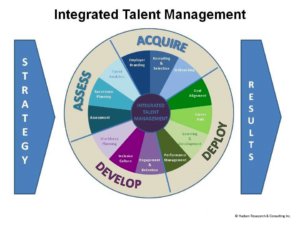Talent management is an important part of company strategy. The job market and employer-employee relationships have been continuously changing over the past several years, and talent management practices with them. What are today’s most effective talent management techniques?
Talent Management: Definition
Talent management means the method used to find rare employee profiles, optimise their potential and retain them. This means that HR Directors need to find a balance between recruiting the best employees, retention and company goals. The resulting talent management model is therefore based on an elaborate, wide-reaching system that covers the employee’s entire career, from hiring procedures to retirement. This model also needs to be constantly adjusted as employee expectations change.
The Process of Talent Management
Talent management must be rigorously and methodically applied. These are the key steps:
1. Planning: first, you must determine the company’s personnel needs. To do this, you must map out specific profiles for positions to be filled or created, as well as specialised recruitment plans.
2. Attracting: HR reps have a wide range of sourcing tools and techniques for attracting interesting profiles, such as CV libraries, social media and job search platforms. The employer’s brand or employee benefits are also undeniable advantages for attracting rare gems.
3. Selecting: individual interviews, virtual group workshops, written tests or psychometric testing, there are many ways to choose the best applicants. These techniques allow you to quickly identify an applicant’s character and useful skills.
4. Developing: many companies prefer soft skills to an excellent CV when they recruit. This means that they choose to train their talents internally, helping them acquire the skills the company needs. This strategy encourages employees to commit to the company and helps with retention, particularly if the employer makes the effort to provide a variety of personalised training options including mentoring, conferences, job rotation, etc.
5. Retaining: keeping top talents is a priority. This is where validation and recognition strategies come in. Internal mobility, promotions and flexible benefits plans help keep employees committed to the company.
6. Transitioning: support throughout their career is essential for making employees feel like part of the company. Helping them get ready for retirement or allowing them to pass their skills on to others through a tutoring programme are good ways to facilitate the transition between generations of employees and further the employer’s investment.
Therefore, there are several primary factors to consider when developing a talent management model:
- • Strategies for attracting employees through company culture and integration techniques
- • Evaluating internal talent
- • Implementing a variety of retention tools
- • Career development
Effective Talent Management Strategies
Talent management doesn’t work without a variety of finely tuned strategies. You should focus on:
1. Precise Job Descriptions
The more exhaustive your job offers are, the better you will target applicants and the less time you will spend on recruitment. Indispensable information includes the job title and location, skills and experience required, pay and benefits, as well as the start date.
2. Employee-Employer Matching
Choose applicants that fit with your company culture. If the person is not a good fit for your organisation, you will likely spend a lot of time trying to get them to adjust. This factor is an indication of whether the applicant will commit to the company and improves satisfaction of your future employees.
3. Individual Rewards
Your rewards programme is the key to motivating your best employees. Use financial bonuses or custom benefits packages. Rewards must also be accompanied by non-financial recognition, such as the option for flexible scheduling or internal company services such as dry-cleaning, athletic training, childcare, a hairdresser or barber. This is a great way to make your employees’ lives easier.
4. Talent Review
This means making a list of your most promising employees, and then ranking them by their efficiency and results. A Talent Review is a great way to identify company resources.
5. Collaborative Career Plans
When you create a professional development plan in collaboration with each employee, you provide them with long-term opportunities at your company, encouraging retention. These career plans should be based on realistic goals and spread out over time to ensure employee motivation. This way, you will give them the tools they need to manage the increasingly complex changes taking place in the professional world. A win-win strategy for employers and their employees.
